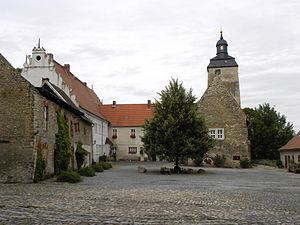Egeln moated castle
| Egeln moated castle | ||
|---|---|---|
|
Inner courtyard of the Egeln moated castle, from the east |
||
| Castle type : | Niederungsburg | |
| Conservation status: | partially restored | |
| Standing position : | Adelsburg, table goods | |
| Place: | Leeches | |
| Geographical location | 51 ° 56 '38.3 " N , 11 ° 26' 15.4" E | |
| Height: | 75 m above sea level NHN | |
|
|
||

The Egeln moated castle is a moated castle near Egeln in the Salzlandkreis in Saxony-Anhalt .
Geographical location
The Wasserburg Egeln is located about 250 m east of the center of Egeln, a small town in the Magdeburg Börde . It stands in the fertile Egelner Mulde lowland part of the Saale tributary Bode . The moat, which is filled with water, is fed by the Hundegraben ( Hunnengraben ) coming from the northwest, which drains into the Bode via the Mühlgraben, which runs east-south-east, at nearby Unseburg . The castle stands at a maximum of about 75 m above sea level. NHN .
history
The village of Egeln was first mentioned in a document in 941, in which King Otto I gave the places " Osteregulun ", Westeregulun and part of the Hakelwald to Siegfried, the son of Margrave Gero , whom Otto I had christened . Siegfried died early in a campaign against the Slavs and Margrave Gero founded the Gernrode Monastery to protect his daughter-in-law Hathui, which Egeln now owned.
In that first document a new fort is mentioned. This served to protect the ford through the Bodefluss, in front of which the military roads from Erfurt , Quedlinburg and Goslar met, which united to one road led on to Magdeburg , the first capital of the Holy Roman Empire of the German Nation . Craftsmen and traders settled in front of this fort and a market settlement was established which was frequented by many travelers. Since the fort with its extensive defenses, located between two arms of the Bodensee, hindered the further development of the settlement, the Ascanians laid in 10/11. Century a planned new town northeast of the Bode with market and church under the protection of a new castle.
This was conquered in 1250 by the nobles of Hadmersleben , who moved their headquarters to the Egelner Castle and now called themselves the Lords of Egeln. They fortified the place with a strong wall and gave it market and town rights. In 1259, at the request of Otto the Elder's wife , Jutta von Blankenburg, they founded the Marienstuhl Monastery on the site of the old fort, which was now outside the city gates .
When Count Curd von Hadmersleben zu Egeln died in 1416 without male descendants, Egeln came through the Counts of Barby in 1418 to the cathedral chapter of Magdeburg Cathedral , which converted the castle into a palace and used it as a summer residence and table goods . The castle captain or Vogt appointed by the cathedral chapter also had jurisdiction over the seven villages belonging to the Egeln office .
Under Archbishop Günther II von Schwarzburg (1403–1445 / 45) the castle was converted into a late Gothic complex, the outer bailey was expanded and further barns and stables were built. During the Thirty Years' War it was temporarily the headquarters of the Swedish Army and the residence of Field Marshal Johan Banér . She was then Prussian domain and as a lease awarded to deserving officers.
After 1945 the complex was a state-owned property , but there was little interest in preserving the historic buildings, so that a period of increasing decline began. In 1987 the Egeln watchmaker Hans Grube succeeded in winning the director of the estate for the "Aktion Wasserburg" and thus preventing a city council decision to completely fill the already silted-up moat with rubble.
In 1993 the keep and the gatehouse were restored and since then they have housed the Egelner Museum for Pre-, Early- and Town History. In October 1995 the castle complex came into the possession of the city of Egeln and is planned to become the city's cultural center in the long term.
Todays use
On the upper castle with open-air stage, creative center and cellar theater, events of various kinds take place all year round. In the foyer of the museum is the possibility of civil marriage ceremony . The Romanesque vault offers the opportunity to hold celebrations. In Palas there is a place to stay in 2008.
Localities of the Egeln District 1648
The following villages belonged to the Egeln office in 1648 :
- Egeln (Altenmarkt)
- Old Weddy ( Altenweddingen )
- Atzendorff
- Bleckendorff (now: Egeln-Nord)
- Ottersleben (wrong for Etgersleben)
- Schwaneberg (Sülzetal)
- Tartün (Tarthun)
- Wollmerssleben ( Wolmirsleben )
Individual evidence
- ↑ Saxony-Anhalt viewer of the State Office for Surveying and Geoinformation ( notes )



